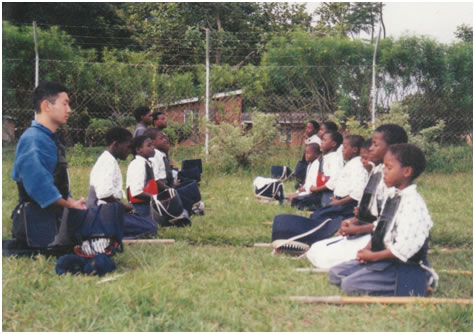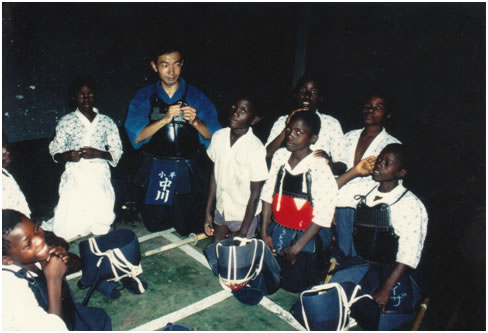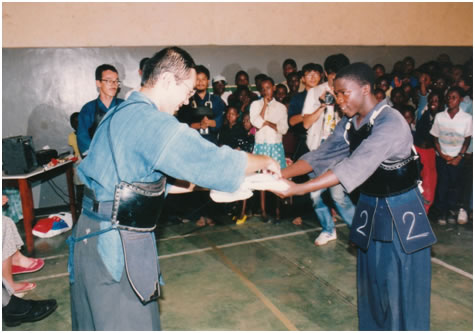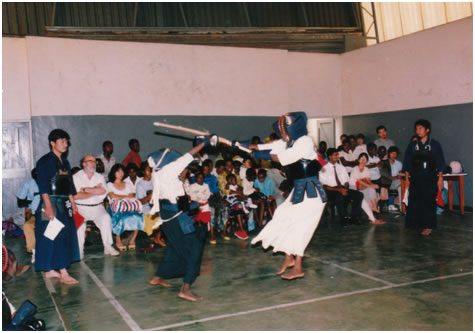Japan through Malawian eyes
Edited. 2013 December
Mr. Austinie Somba -Promoting Kendo in Malawi for 20 years-
Mr. Austinie Somba
Mr. Somba learned the art of Kendo, a Japanese martial art, from a JOCV volunteer in the early 1990s. Since then he has devoted himself to the promotion of Kendo in Malawi. He is now the president of Kendo Association of Malawi. Recognizing the association’s persistent effort in contributing to the cultural exchange between Japan and Malawi, the Ministry of Foreign Affairs, Japan awarded Kendo Association of Malawi the Foreign Minister's Commendation in 2013. This award is given to individuals and groups of outstanding achievements in international fields, to acknowledge their contribution to the promotion of friendship between Japan and other countries. Kendo Association of Malawi has become the first recipient of this award in the whole of Malawi.
|

|
-What made you start Kendo?
It came more or less as a childhood pleasure after seeing a JOCV member practicing Kendo. That time I was just around 13-14 years old. My father used to work at the Queen Elizabeth Central Hospital in Blantyre and so I used to visit the hospital quite often. There I saw a Japanese gentleman, Mr. Nakagawa practicing Suburi (practice swings) with a Shinai (bamboo practice swords) that he had brought from Japan during his lunch break. He was a JOCV volunteer at the hospital working as a dietician. Out of interest, I and my other friends approached him and asked what he was doing. He explained that he was practicing a Japanese traditional art of Kendo. We were extremely fascinated with the sport and asked if he could teach us the art. Because there was no equipment, we actually started learning Kendo by using mop-sticks! As other children saw us practicing, they also showed interest, and so Mr. Nakagawa started to teach us as a group. It was well back in 1992. Most of these children had either of their parents working at the hospital. I was in the final year of the primary school and I used to run back from school so that I could practice with Mr. Nakagawa.
-How did your group grow?
The group was a combination of my age group (13-14 years old) and some even younger children (5-7 years old). As we started to practice Kendo and came to know what Kendo was all about, then our interest kept on growing. We then requested him to teach us seriously because initially the teaching was more like a pastime activity. However, that time he only had two Shinaisand so it took us another while to start a proper training. I remember my initial impression of Kendo was that it was like Ninja. After taking a glance at the Shinai and listening to Mr. Nakagawa’s explanation, I could only associate them to the Ninjas I saw in the movies. But gradually I came to learn Kendo was much deeper than what I imagined. I therefore started to take Kendo practices very seriously and I and the other members asked Mr. Nakagawa if we could get equipment. Mr. Nakagawa requested JICA to assist us with some sets of equipment and we got about 10 sets of the equipment. Everybody was excited to put on Bogu (armour) for the first time.
Around that time we also realized that we had to approach the authorities if we were to continue the practice of Kendo. During those days, ordinary citizens were not allowed to learn or practice any kind of martial arts. We thus recommended Mr. Nakagawa to approach National Council of Sports of Malawi just to give them a brief description of Kendo in order for the Sports Council to appreciate Kendo as a sport and to consequently allow us to practice it. The Council came to see our activities to assess the relevance of Kendo and eventually we were able to practice Kendo as a sport.
-How did the group manage to keep the solidarity and grow further after Mr. Nakagawa left?
After Mr. Nakagawa left, it took a little bit of time before we had another JOCV member join the group. I would call him as a care taker as he was a link between Mr. Nakagawa and the small grouping that we had formed. This gentleman knew Kendo and had a second dan (grade). A year later he left also. Over the years, a few more JOCV members joined and helped our group although there was also a time where there was no JOCV in our group. Some of these JOCV members did not practice Kendo themselves, however they taught us a great deal in how to run the affairs of the group, and advised us on organizing the group into an association. Eventually I took over the responsibility of teaching Kendo as well as of running the affairs of the association along with some other members.
-What is it like to teach the art of Kendo, not only to convey its physical skills but also its cultural values?
Upon taking up Kendo, I came to learn that the sport embraced a lot of elements other than physical strength. I saw discipline being one part and spiritual development as another part.
Back in the days when we first started practicing Kendo, only a few people really understood that Kendo was not about being violent. From Mr. Nakagawa’s point of view, his behavior and anything he would do in association with kendo had to be taken as the examples of what Kendo was about. Eventually we came to appreciate whatever values he taught us in relation to the sport. He often said we had to work hard at school. This was something contrary to what people expected from martial art. All the time he used to encourage us to work hard in all that we were doing. He would say, ‘in each and everything you do, don’t give up’. Through these words we came to build an understanding that Kendo was more than a sport. By and large these teachings are a part of me now. Interestingly enough Kendo has been able to shape my character somehow. How I behave and how I see things are very different from how I used to before encountering with Kendo. I really think Kendo has added value to my life. I wouldn’t say I was a naughty child as I grew up in a Christian family where morals are taught and anything against them were punishable by my parents. I think taking up Kendo was able to enrich these Christian values I learned.
-What is it like to teach these values to a new generation of Malawians?
Frankly speaking I don’t find a big challenge in teaching the values to the younger members of our association because we are looking at people who are somehow in a system where morals are there, unlike certain cultures or societies where you have to start from scratch. It is not difficult to teach the moral values of Kendo to Malawians as they are able to embrace what they feel morally right.
-What are the motivations of the pupils who join the group?
Now people know what kendo is all about unlike during our time when we had no idea and thus automatically concluded that Kendo was something to do with Ninjas! Some take up Kendo as a means of achieving self-discipline while others take up the sport with a view of learning self defense. Some join also for association- to make friends.
-What are the challenges you face as a group?
Challenges are there, numerous of them. Teaching of the art itself is not a challenge but if you think about other things that support the implementation and facilitation of teaching, there are a lot of challenges. Procurement of the equipment is one challenge as you cannot find them locally and they are expensive so we cannot buy them so easily. Although I wouldn’t say this is a big challenge, financing can be difficult from time to time. But where there is a will, there is always a way, so many times I don’t count that as a major challenge. Another area is that we really lack in skills. At the time Mr. Nakagawa taught us, it was a serious lesson but since then we haven’t had experts teaching us. We would really appreciate it if a Kendo player of a highly advanced stage could once again come and instruct us. Of course, the training facility is a challenge also. We were indeed practicing on concrete floor before we were donated the new flooring by Malawi Society of Japan.
-How can Kendo be promoted in Malawi?
One way is for us to partake in cultural shows that the Embassy organizes. Another way, which I would really like to put forward for your consideration is if we could have a game organized once a year with the Embassy’s support- that would really be great. Like an Ambassador’s trophy or something. That would help promote the sport. Also, putting info on webpage as you are doing is beneficial.
-Finally what did it mean for you and your association to have received the Foreign Minister's Commendation?
That was a great honor. Being the first recipient of such an honor in the country is just unbelievable. We didn’t take it for granted. Actually, we never expected to receive such recognition. This gave us a great motivation to continue what we are doing. Furthermore, the members were finally able to see that what we had been doing for twenty years had a meaning beyond. During the twenty years, nobody in Malawi came forward to commend us. Kendo is a minority sport in this country. But finally, the Japanese Government came forward and told us that what we have been doing is very special and is a valuable contribution to the cultural exchange between Malawi and Japan. Simply put, it was a great honor.
(Click here for the photos from the awarding ceremony of the Foreign Minister's Commendation)

When the members first wore the Bogu (armour)

The group moved Dojo(practice place) to the Blantyre Youth Centre (government facility for sports) in 1993

Mr. Somba became the winner of the first championship held in November 1993

A scene from the tournament in November 1993

Mr. Somba in a match (on the right hand), in 2013

On the flooring donated by Malawi Society of Japan in 2013

With Mr. Nakagawa who revited Malawi, at the awarding ceremony of the Foreign Minister's Commendation in 2013
(Mr. Somba at the right end)
|
| Copyright (C): 2012 The Embassy of Japan in Malawi |
|



